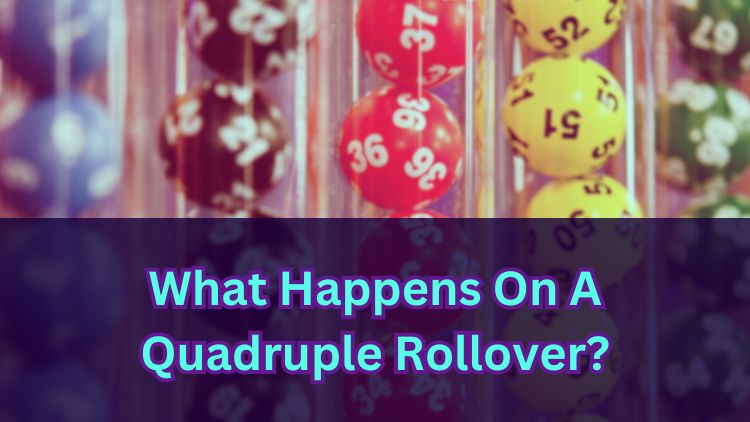
If you have encountered the term “quadruple rollover”, you may be curious about its meaning in relation to games such as the National Lottery. Whether you are unfamiliar with how lottery games work or just looking to better understand how jackpot amounts increase, gaining a clearer view of rollovers could provide some useful context.
This guide outlines what a quadruple rollover is, how it influences the jackpot, and where it fits within the broader framework of lottery draw systems. Read on to learn more.
How Lottery Rollovers Work
A lottery rollover takes place when no tickets match all the main numbers required to win the top prize. If this happens, the jackpot is not claimed and rolls over to the next draw. This causes the prize to increase, as it includes the unclaimed jackpot along with new ticket sales.
In the UK National Lottery’s Lotto game, the jackpot can roll over up to five times. After the fifth rollover, a “Must Be Won” draw is introduced. This means the jackpot cannot roll over again and must be distributed in that draw.
As more players take part during rollover draws, the jackpot can grow more significantly. If you're considering entering a game, it could be useful to check the individual rules for that specific lottery as formats and rollover limits vary.
What Makes a Quadruple Rollover Different?
A quadruple rollover means the jackpot has rolled over four times in a row. This follows four consecutive draws with no top prize winner. It is the draw just before the potential “Must Be Won” event if no jackpot winner appears in the next round.
In Lotto, this draw does not yet trigger the Must Be Won conditions. However, it marks the point where the jackpot has reached four unsuccessful draws. This stage often draws attention due to the size the jackpot can reach by this point.
Different lotteries have different rollover structures. It may be useful to review the rules of any game before taking part, particularly if it follows a different rollover or prize distribution model.
Is a Quadruple Rollover a Must Be Won?
A quadruple rollover is not classed as a Must Be Won draw. In the UK Lotto, that specific draw only occurs if the jackpot is not won for five consecutive draws. The draw immediately following the quadruple rollover would be the fifth draw. If no one wins the jackpot in that fifth draw, the Must Be Won rules apply.
If you are following the progress of a growing jackpot, a quadruple rollover represents the step just before the Must Be Won conditions could be introduced. At this point, the jackpot continues to roll and accumulate based on further sales.
Must Be Won Rules Explained
Once the fifth rollover has passed without a jackpot winner, the next draw becomes a Must Be Won event. In this draw, if nobody matches all six main numbers, the jackpot is no longer rolled forward. Instead, the prize fund is shared between winners in the lower prize categories. This process is known as a roll down.
In Lotto, this can include a fixed £5 prize for players who match two main numbers during the Must Be Won draw. The rest of the jackpot is divided between players who match three or more numbers. The amount awarded in each prize tier depends on how many winners fall into that category during the draw.
The purpose of this structure is to prevent the jackpot from rolling indefinitely. Each lottery game will outline how it handles such cases, so it might be useful to check the official rules for any differences.
When a Roll Down is Triggered in Lotto
A roll down occurs only after five consecutive rollovers and if there is still no jackpot winner in the sixth draw. The jackpot is then distributed among other prize tiers.
In a Lotto roll down, players who match two main numbers receive a fixed £5, while those matching three, four, five, or five plus the bonus number receive a proportion of the remaining jackpot. The shares are determined by the prize structure in place for that draw.
This approach makes it possible for players in lower categories to receive a larger prize than in standard draws. The prize levels will vary depending on how many winners are in each group.
You can find more detailed information about how this process works by visiting the official Lotto website or reading the terms that come with your selected lottery.
Rollover vs Roll Down: The Differences
Rollover and roll down refer to different phases of jackpot progression in Lotto.
-
Rollover: When there is no jackpot winner and the top prize is added to the next draw.
-
Roll down: When the maximum number of rollovers has been reached, and the jackpot is shared between lower prize tiers.
A rollover allows the jackpot to increase over several draws. A roll down ensures that the jackpot is distributed if it is not won after the set number of rollovers.
Understanding where a quadruple rollover fits into this structure may help you keep track of what stage a jackpot is at and how prizes may be distributed in the following draw.
For further details, you can visit the official National Lottery site. If you choose to enter any lottery game, it could be wise to check the rules beforehand and take part only if it suits your preferences and budget. Always remember to gamble responsibly and within your means- never wager more than you can afford to lose.
**The information provided in this blog is intended for educational purposes and should not be construed as betting advice or a guarantee of success. Always gamble responsibly.
*All values (Bet Levels, Maximum Wins etc.) mentioned in relation to these games are subject to change at any time. Game features mentioned may not be available in some jurisdictions.
